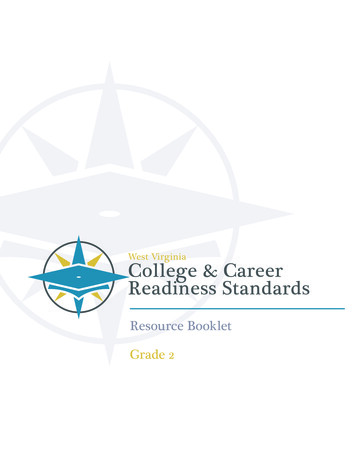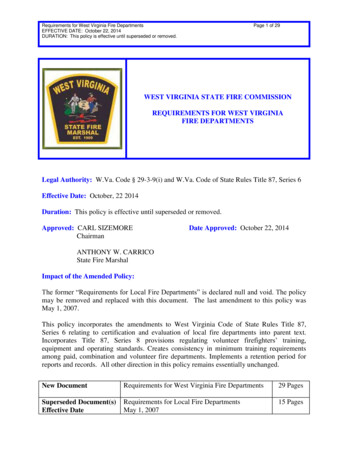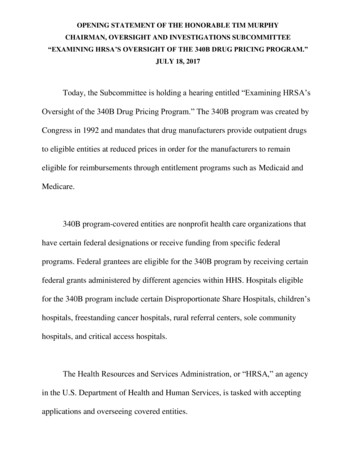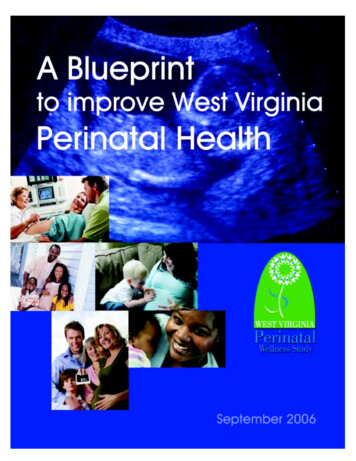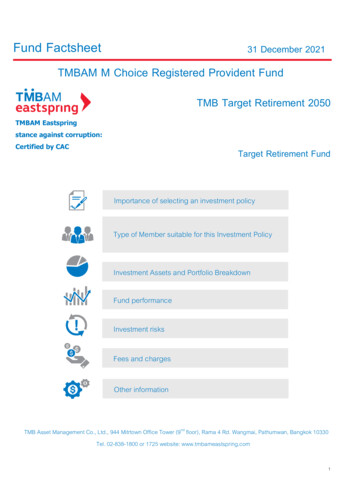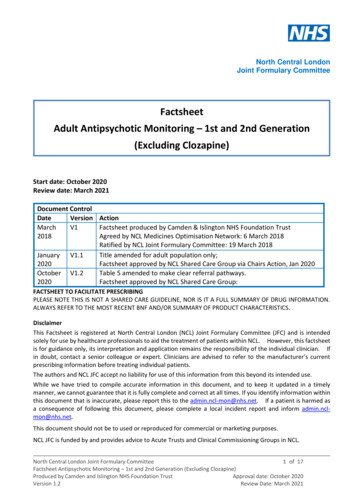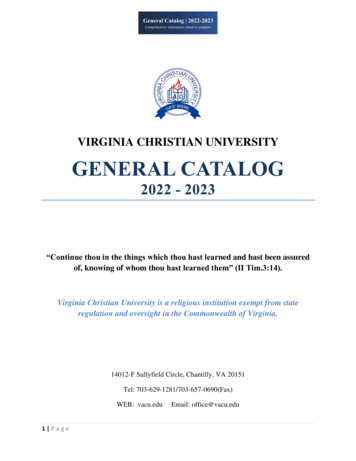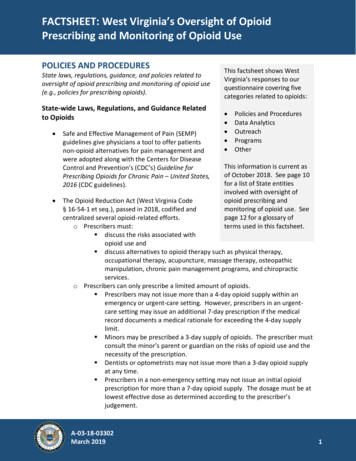
Transcription
FACTSHEET: West Virginia’s Oversight of OpioidPrescribing and Monitoring of Opioid UsePOLICIES AND PROCEDURESState laws, regulations, guidance, and policies related tooversight of opioid prescribing and monitoring of opioid use(e.g., policies for prescribing opioids).State-wide Laws, Regulations, and Guidance Relatedto Opioids Safe and Effective Management of Pain (SEMP)guidelines give physicians a tool to offer patientsnon-opioid alternatives for pain management andwere adopted along with the Centers for DiseaseControl and Prevention’s (CDC’s) Guideline forPrescribing Opioids for Chronic Pain – United States,2016 (CDC guidelines).This factsheet shows WestVirginia’s responses to ourquestionnaire covering fivecategories related to opioids: Policies and ProceduresData AnalyticsOutreachProgramsOtherThis information is current asof October 2018. See page 10for a list of State entitiesinvolved with oversight ofopioid prescribing andmonitoring of opioid use. Seepage 12 for a glossary ofterms used in this factsheet.The Opioid Reduction Act (West Virginia Code§ 16-54-1 et seq.), passed in 2018, codified andcentralized several opioid-related efforts.o Prescribers must: discuss the risks associated withopioid use and discuss alternatives to opioid therapy such as physical therapy,occupational therapy, acupuncture, massage therapy, osteopathicmanipulation, chronic pain management programs, and chiropracticservices.o Prescribers can only prescribe a limited amount of opioids. Prescribers may not issue more than a 4-day opioid supply within anemergency or urgent-care setting. However, prescribers in an urgentcare setting may issue an additional 7-day prescription if the medicalrecord documents a medical rationale for exceeding the 4-day supplylimit. Minors may be prescribed a 3-day supply of opioids. The prescriber mustconsult the minor’s parent or guardian on the risks of opioid use and thenecessity of the prescription. Dentists or optometrists may not issue more than a 3-day opioid supplyat any time. Prescribers in a non-emergency setting may not issue an initial opioidprescription for more than a 7-day opioid supply. The dosage must be atlowest effective dose as determined according to the prescriber’sjudgement.A-03-18-03302March 20191
FACTSHEET: West Virginia’s Oversight of OpioidPrescribing and Monitoring of Opioid Useo Insurance providers operating in West Virginia must provide coverage for20 visits per event of alternative therapy when ordered by a health carepractitioner to treat conditions that cause chronic pain.o West Virginia also clarified that for patients who continue to receive opioidprescriptions, prescribers must: discuss a plan for discontinuing opioids to reduce the potential for abuseor dependence and discuss the benefits of seeking treatment through a pain clinic orspecialist and make a referral as appropriate.Medicaid Policies Related to Opioids West Virginia uses the Medicaid 1115 Substance Use Disorder Waiver (the Waiver) toexpand its benefits package and build a comprehensive State-wide strategy forcombating drug misuse and substance use disorders. The State divided the expansioninto two phases:o Phase I of the Waiver began in January 2018 and included: implementing the Screening, Brief Intervention, and Referral toTreatment (SBIRT) tool to identify substance use disorder treatmentneeds; establishing methadone treatment and related counseling services asMedicaid-covered strategies for withdrawal management; and implementing the Naloxone Distribution Initiative to make the opioidantagonist naloxone widely available and increase awareness of itsbenefits in reversing the effects of an overdose.o Phase II of the Waiver began in July 2018 and expanded coverage to include: Adult Residential Treatment: services adhering to the American Society ofAddiction Medicine (ASAM) criteria; Peer Recovery Support Services: services providing access to trained andcertified peer recovery specialists who can extend the reach of treatmentbeyond the clinic; and Withdrawal Management Services: a licensed program providingshort-term medical services on a 24-hour basis. These services includestabilizing intoxicated Medicaid beneficiaries, managing withdrawal, andfacilitating access to substance use disorder treatment as neededaccording to a comprehensive assessment.o As part of the Naloxone Distribution Initiative, West Virginia will reimburseproviders for the cost of naloxone, the administrative costs associated withadministering naloxone to Medicaid beneficiaries, and for the cost of providingMedicaid beneficiaries with information about and referrals to addictiontreatment programs.A-03-18-03302March 20192
FACTSHEET: West Virginia’s Oversight of OpioidPrescribing and Monitoring of Opioid UseLaws, Regulations, and Guidance on Prescription Drug Monitoring Program Data Senate Bills (SBs) 437 (2012) and 339 (2017) amended the Code of West Virginia todefine how West Virginia Controlled Substance Monitoring Program (CSMP) data maybe shared with prescribers, State agencies, law enforcement, researchers, and others.o SB 437 (2012) amended several articles of West Virginia Code to add certainrequirements and training that law enforcement officials must comply with andcomplete to access the CSMP database. SB 437 also permits the CSMP DatabaseReview Committee to query the CSMP database, requires the Board of Pharmacy(BoP) to review the CSMP database to issue certain reports, and permits the BoPto share certain CSMP database information with the West Virginia Departmentof Health and Human Resources (DHHR).o SB 339 (2017) (West Virginia Code § 16-52-1 et seq.) created the Coalition forResponsible Chronic Pain Management in 2017 and details the Coalition’spowers, duties, and membership. The Dean of the School of Public Health atWest Virginia University, or his or her designee, serves as the Coalition’s chair.The Coalition reviews chronic pain regulations and the CMSP database andprovides guidance to the West Virginia legislature on potential solutions relativeto chronic pain medications. West Virginia Code section 60A-9-5a requires all practitioners who prescribe or dispenseSchedule II, III, or IV controlled substances to register with the CSMP. Thosepractitioners and pharmacies must document the information obtained from CSMPsearch in the patient’s medical record. A prescriber is required to check the CSMPdatabase when issuing an initial prescription. If the prescriber continues to treat thepatient with a controlled substance, the prescriber must continue to check the CSMPdatabase at least annually. West Virginia Code section 16-5H-4(7) states that a physician in a licensed painmanagement clinic must check the CSMP database when issuing an initial prescription.If the physician continues to treat the patient with a controlled substance, the physicianmust continue to check the CSMP at least every 90 days.Laws, Regulations, and Guidance Related to Treatment West Virginia does not have a State-run Opioid Treatment Program (OTP); however,State law specifies licensing and registration requirements for facilities and physiciansthat treat patients with substance abuse disorders and ensures that all West VirginiaOTP medication-assisted treatment and office-based medication-assisted treatmentprograms conform to a common set of minimum standards (West Virginia Code§ 16-5Y-1; West Virginia Code of State Rules § 69-11-1; and West Virginia Code of StateRules § 69-12-1).A-03-18-03302March 20193
FACTSHEET: West Virginia’s Oversight of OpioidPrescribing and Monitoring of Opioid Use West Virginia offers recovery services for people addicted to opioids. The West VirginiaBureau for Behavioral Health and Health Facilities (BHHF) leads West Virginia’s efforts toincrease the awareness and use of medication-assisted treatment programs.Laws, Regulations, and Guidance on Naloxone State law made opioid antagonists more accessible, especially for those who are mostlikely to have or witness an overdose.o SB 335 (2015) added West Virginia Code sections 16-46-1 through 16-46-6 toallow licensed health care providers to prescribe an opioid antagonist to firstresponders, individuals at risk of having an overdose, and relatives and friends ofindividuals at risk of having an overdose. Providers dispensing opioidantagonists must provide educational materials on overdose prevention andtreatment programs as well as materials on administering opioid antagonists torecipients.o SB 431 (2016) added West Virginia Code section 16-46-3a to authorizepharmacists to dispense an opioid antagonist without a prescription according toan established protocol. A dispenser providing an opioid antagonist without aprescription must provide educational materials and a mandatory patientcounseling to the individual receiving the opioid antagonist.o SB 272 (2018) amended West Virginia Code section 16-46-4 to require local andState government agencies to require first responders to carry opioidantagonists subject to certain conditions as long as there are sufficient suppliesand funding. SB 272 (2018) also added West Virginia Code section 16-46-7,which states that the State health officer may use standing orders to prescribean opioid antagonist on a State-wide basis to certain recipients.DATA ANALYTICSData analysis that the State performs related to opioid prescribing and monitoring of opioid use(e.g., analyzing data to determine the number of opioid prescriptions written by providers todetect high-prescribing providers). West Virginia cooperates with many different stakeholders to combine datasets intouseful information. The State government group most responsible for coordinating datais a team working in the DHHR, Bureau for Public Health (BPH), Office of Maternal, Child,and Family Health (OMCFH), in collaboration with the Violence and Injury PreventionProgram.o The main data source is the CSMP database, which is held in custody of the BoP.The BoP hired three former West Virginia DHHR employees (two epidemiologistsand one data analyst) to analyze and compile data from the CSMP and providethat information, with personal identifying information removed, to OMCFH stafffor public health surveillance use.A-03-18-03302March 20194
FACTSHEET: West Virginia’s Oversight of OpioidPrescribing and Monitoring of Opioid Useo Other data sources include emergency medical services runs, violent deathsurveillance, Medicaid claims, the Public Employees Insurance Agency (PEIA),corrections data, birth and death certificates, and birth scores.o DHHR’s Bureau for Medical Services (BMS) and the PEIA provide medicalcoverage to approximately 66 percent of West Virginia residents, which allowsState analysts to collect health experience data for a large portion of WestVirginia’s population. West Virginia performs analytics on its own Medicaid claims data. With the assistanceof outside vendors, which include claims processors, the Drug Utilization Review (DUR)committee, and data warehouses, West Virginia creates utilization reports to allow foridentification of at-risk Medicaid beneficiaries and high-prescribing physicians. West Virginia creates SEMP reports that detail the percentage change in thepopulation’s morphine milligram equivalent use beginning at intake and organize thisinformation according to patients’ risk assessment levels. OMCFH compiled information from multiple resources to publish a comprehensiveOverdose Fatality Analysis report in 2017. Some data analysis is intended specifically for quality improvement interventions, andother analysis is intended for internal policy development and decision making.o The DUR Committee sends prescriber reports to high-prescribing providersbased on data analytics.o The DUR Committee uses data analysis to evaluate prescribers and patients, andpatients identified as at-risk can be “locked into” seeing a specific primary carephysician, hospital, or pharmacy.OUTREACHOutreach that the State provides related to preventing potential opioid abuse and misuse (e.g.,opioid-related training for providers).Outreach to Providers BMS publishes eight annual newsletters, some of which have covered treatmentguidelines for pain, opioid prescription, and the use of naloxone. West Virginia sent a letter signed by the BMS Director of Pharmacy to Medicaid healthcare providers to announce West Virginia’s adoption of the CDC guidelines. West Virginia supplied health care providers with colored charts and graphics of theSEMP guidelines for patient reference to facilitate communication during in-personvisits.A-03-18-03302March 20195
FACTSHEET: West Virginia’s Oversight of OpioidPrescribing and Monitoring of Opioid Use The BHHF, in partnership with the University of Charleston School of Pharmacy, hosteda one-day, in-person training titled, “Addressing Opioid Overdose: Understanding theRole of Prevention,” for prevention practitioners. The BHHF created and maintains a webpage with links to resources for office-basedmedication-assisted treatment. The BHHF facilitated a Substance Abuse and Mental Health Services Administration(SAMHSA) training for prescribers. The training, “Partnering for Opioid AddictionPrevention,” included an overview of ASAM’s strategic plan, which providers funded bythe Waiver must apply when providing treatment services.Outreach to Patients House Bill 2195 (2017) requires comprehensive drug awareness and preventionprograms in all public schools. BPH makes opioid abuse prevention information available through its website, andDHHR produced a West Virginia Overdose Response Video to provide additionalinformation. BHHF’s Health and Hope West Virginia website also provides informationabout opioid abuse prevention.PROGRAMSState programs related to opioids (e.g., opioid-use-disorder treatment programs).Prevention ProgramsSafe and Effective Management of Pain SEMP is a geographically and professionally diverse expert panel of West Virginians,including DHHR executive personnel, formed with the intention of making guidelines forthe safe and effective management of pain to build upon the CDC guidelines. SEMP’sefforts result in clinical pain management algorithms based on best practices, clinicalexperience, and evidence-based literature.Unused Medication Program West Virginia created the Dispose Responsibly of Prescriptions (DRoP) Program toreduce the presence of unused prescription medication in the general public.o The DRoP Program provides permanent drug drop boxes to law enforcementagencies across the State.A-03-18-03302March 20196
FACTSHEET: West Virginia’s Oversight of OpioidPrescribing and Monitoring of Opioid Useo The West Virginia Attorney General expanded the program in 2014 to increaseaccess to disposal locations.o As of February 2018, there are 85 DRoP Program locations in West Virginia.Detection ProgramsScreening, Brief Intervention, and Referral to Treatment SBIRT is a West Virginia tool implemented by community-based behavioral healthcenters, rural community-based primary health care clinics, trauma units, andschool-based health clinics. In SBIRT, a health care provider has a conversation with apatient to assess life experiences to determine the suitability for early intervention forsubstance misuse and abuse. BMS used the Waiver to add the SBIRT screening tool toidentify substance use disorder treatment needs.Controlled Substance Monitoring Program BPH uses CSMP data to identify on a county-level areas of the State with at-risk behaviorby Medicaid beneficiaries and opioid prescribers. Although BoP is responsible for the CSMP, BPH receives a bulk data feed of CSMP datafor all West Virginia prescriptions distributed. Information from the CSMP is sent toOMCFH staff. West Virginia does not share CSMP data with other States; however, West Virginia isworking on sharing its methods and practices with other States interested in creatingsimilar structures and partnerships.Lock-In Program The DUR committee is part of BMS’s Pharmacy Division. Each month, the DURcommittee reviews patient files that are referred by a Medicaid claims contractor andidentified as having at-risk behavior that meets certain criteria. The DUR committeeuses Medicaid data to conduct the reviews. If the reviewed case qualifies, thebeneficiary is then locked into one pharmacy for 12 months. The purpose of the lock-in program is to provide enhanced coordination of care formembers who may be at risk for adverse effects due to the potential overutilization ofcontrolled substances. The DUR committee notifies physicians and pharmacists by letter when it identifiespotential problems.A-03-18-03302March 20197
FACTSHEET: West Virginia’s Oversight of OpioidPrescribing and Monitoring of Opioid UseOpioid Treatment Programs West Virginia has nine licensed OTPs, none of which are State-operated. In 2007, WestVirginia stopped granting licenses for new OTPs due to facilities failing to meet licensingrequirements. West Virginia officials stated that they believe that the current numberof facilities provides sufficient geographic coverage, but West Virginia can grantadditional licenses if the need for more facilities arises. The Office of Health Facility Licensure and Certification licenses and certifies treatmentprograms and is the regulatory authority for corrective actions.o Each OTP must: be registered and be licensed by the Secretary of DHHR, the West VirginiaSecretary of State, and the State Tax Department; comply with West Virginia’s BoP regulations; receive approval from the Drug Enforcement Administration; and receive approval from SAMHSA’s Center for Substance Abuse Treatment.o OTPs are regulated through State law (West Virginia Code § 16-5Y; Code of StateRules § 69-11-1; and SB 437 §16-1-4 (2012)) and Federal regulations (42 CFRpart 8). OTPs provide a combination of outpatient substance-use-disorder counseling serviceswith medication reviewed and administered by medical staff. Most OTPs in WestVirginia dispense methadone, buprenorphine, and naltrexone products.OTHEROther State activities related to opioids that are not covered by the other categories in thisfactsheet. West Virginia’s Governor’s Advisory Council on Substance Abuse (GACSA), ExecutiveOrder 5-11, was established in 2011 to provide guidance, recommend priorities forimprovement, identify planning opportunities, and provide recommendations to theGovernor. It was rescinded and replaced in 2017 by Executive Order 10-17, whichestablished the West Virginia Governor’s Advisory Council on Substance Use Disorder. Help4WV is a State-sponsored treatment referral and information service for individualsand families facing mental or substance use disorders. Help4WV is a free, confidential,24-hour service offering call, chat, and text communication to provide immediate helpfor any West Virginian with a mental or substance use disorder.A-03-18-03302March 20198
FACTSHEET: West Virginia’s Oversight of OpioidPrescribing and Monitoring of Opioid Use The West Virginia Comprehensive Substance Abuse Strategic Action Plan is a reportpublished by the task forces associated with GACSA. The report identifies four Stategoals:o to implement an integrated approach for the collection, analysis, interpretation,and use of data;o to promote and maintain a competent and diverse workforce;o to increase access to effective person-centered substance abuse prevention,early identification, treatment, and recovery management; ando to provide cooperation between State and local agencies to manage financialresources in providing substance use disorder services. The Opioid Response Plan for the State of West Virginia was developed by DHHR usingpublic engagement and consultation with experts. A group of experts from WestVirginia University, Marshall University, and Johns Hopkins University reviewed publicinput, data, other information, and best practices from around the country to provide afocused set of recommendations. The Ryan Brown Addiction Prevention and Recovery Fund is a special State Treasuryrevenue account that DHHR uses to allocate funds for additional treatment beds forMedicaid beneficiaries eligible for Waiver programs. In December 2017, DHHR awarded 20.8 million to nine programs to expand residential treatment programs across WestVirginia. In February 2018, West Virginia became the first State to receive approval from theCenters for Medicare and Medicaid Services to offer reimbursable Neonatal AbstinenceSyndrome services through the State Medicaid program. Lily’s Place, which opened inOctober 2014, offers observational, therapeutic, and pharmacological care for infantssuffering from prenatal drug exposure. Beginning in February 2018, Lily’s Place becamea recognized Neonatal Abstinence Syndrome Treatment Center, with services providedcovered under Medicaid.A-03-18-03302March 20199
FACTSHEET: West Virginia’s Oversight of OpioidPrescribing and Monitoring of Opioid UseWEST VIRGINIA STATE ENTITIESBureau for Behavioral Health and Health Facilities: BHHF ensures that assistance is availablefor people with mental illness, substance use disorder, and intellectual and developmentaldisabilities. BHHF provides support for families, individuals, and communities providingassistance to individuals enable these individuals to reach their potential and gain control overtheir futures.Bureau for Medical Services: BMS is the State agency responsible for the administration of theState's Medicaid program. BMS provides Medicaid beneficiaries with access to appropriatehealth care.Board of Pharmacy: BoP is responsible for certifying and licensing practitioners and facilities toprovide pharmacist care. BoP also provides the public with access to current laws andlegislative rules and gives the public the ability to file complaints.Bureau for Public Health: BPH oversees health programs and makes information available tothe public.Department of Health and Human Resources: DHHR provides a wide range of necessary andlife-saving services to many West Virginia residents. DHHR’s bureaus and offices focus on WestVirginia residents’ needs, including Medicaid coverage, temporary assistance, public health, andthe West Virginia Children’s Health Insurance Program.Office of Health Facility Licensure and Certification: OHFLAC, situated within the West VirginiaOffice of the Secretary, Office of Inspector General, enforces applicable laws and regulations toshape healthy environments for health care facility clients, patients, and residents bypromoting the quality services and high standards of care that exist when facilities comply withState licensure rules and Federal certification regulations. OHFLAC oversees applications,completes inspections, and responds to complaints made by the public through the OHFLACwebsite.Office of Maternal, Child, and Family Health: OMCFH provides leadership to support State andcommunity efforts to build systems of care. Funded by a Federal block grant from the SocialSecurity Act, Title V, the program seeks to assist, and under special circumstances be a payer oflast resort for, pregnant women, women with infants, children, and youth.Public Employees Insurance Agency: PEIA provides health insurance to public employees andState government retirees.Violence and Injury Prevention Program: This program plays a critical role in informing policystrategies to prevent injury and violence. It supports the implementation and evaluation ofA-03-18-03302March 201910
FACTSHEET: West Virginia’s Oversight of OpioidPrescribing and Monitoring of Opioid UseState, regional, and locally-led evidence-based strategies and activities to reduce and preventinjuries and injury-related deaths.A-03-18-03302March 201911
FACTSHEET: West Virginia’s Oversight of OpioidPrescribing and Monitoring of Opioid UseGLOSSARY OF TERMSControlled Substances Monitoring Program: CSMP is West Virginia’s Prescription DrugMonitoring Program. A Prescription Drug Monitoring Program is a State-run electronicdatabase that tracks controlled substance prescriptions. It helps providers identify patients atrisk of opioid misuse, abuse, or overdose due to overlapping prescriptions, high dosages, orco-prescribing of opioids with benzodiazepines.medication-assisted treatment: Treatment for opioid use disorder combining the use ofmedications (methadone, buprenorphine, or naltrexone) with counseling and behavioraltherapies.morphine milligram equivalents: The amount of milligrams of morphine an opioid dose is equalto when prescribed.naloxone: A prescription drug and opioid antagonist that can reverse the effects of an opioidoverdose and can be life-saving if administered in time. The drug is sold under the brandnames Narcan and Evzio.neonatal abstinence syndrome: A generalized multisystem disorder that producescomplications in newborn babies when exposure to opioids is discontinued at birth.opioids: Natural or synthetic chemicals that interact with opioid receptors on nerve cells in thebody and brain and reduce the intensity of pain signals and feelings of pain. This class of drugsincludes the illegal drug heroin; synthetic opioids, such as fentanyl; and pain medicationsavailable legally by prescription, such as oxycodone, hydrocodone, codeine, and morphine.Opioid pain medications are generally safe when taken for a short time and as prescribed by adoctor, but because they produce euphoria in addition to pain relief, they can be misused.opioid antagonist: An FDA-approved drug such as naloxone or other substance for thetreatment of an opiate-related overdose. When administered, an opioid antagonist negates orneutralizes the effects of an opioid.substance use disorder: Patterns of symptoms resulting from use of a substance that theindividual continues to take, despite experiencing problems as a result.A-03-18-03302March 201912
Addiction Medicine (ASAM) criteria; Peer Recovery Support Services: services providing access to trained and . requires the Board of Pharmacy (BoP) to review the CSMP database to issue certain reports, and permits the BoP . and Family Health (OMCFH), in colla

